Dell XPS 410: Core 2 Duo for the Masses
by Jarred Walton on September 18, 2006 12:20 PM EST- Posted in
- Systems
Internals and Construction
The case design of the XPS 410 is really quite excellent, and many of the well-known case manufacturers could learn a thing or two about creating a tool-less case from it. All of the major components can be accessed quickly and easily without the use of a screwdriver, and we have to think that the assembly-line process at Dell factories is greatly enhanced by the design. After pushing the latch at the top-rear of the case back, the right side panel pops out and you gain access to the interior.
We were given a high-end configuration, complete with almost every accessory that most people would want. This has an interesting impact on the interior appearance, as you basically have a wide open middle section while the top and bottom of the case are more packed with components. The wiring isn't absolutely pristine like you might see in some of the higher end system integrator offerings, but most of the wires are secured at various points to keep them out of the way. Without a case window, we aren't too concerned about a few unsightly wires, and there's still plenty of open space allowing for ample air flow to keep your system interior cool.
At the bottom of the case are the two internal 3.5" drive bays, which are both occupied by 320GB 16MB cache Western Digital drives in our system. Both drives reside in plastic sleds that can be easily removed, but the drives themselves are secured to the sleds with standard screws. Dell set up our drives in a RAID 1 configuration, which will help protect users from data loss and downtime due to a failed hard drive. RAID 1 is not generally considered a backup solution, as it doesn't protect you from accidentally deleted files, viruses, or data corruption issues that might occur, but as a means of improving uptime it is definitely useful. If you need more storage capacity, you can opt for larger drives and/or omit the RAID 1 configuration (or perhaps go with RAID 0 for enhanced performance at the cost of reliability). If you want to add more than two hard drives, you could use the 3.5" or 5.25" external bays (with an adapter for the 5.25" bays).
The 375W power supply had no problems running our test configuration, which is basically loaded up with most of the high-end features you might want to add. A third or fourth hard drive would use a bit more power, as would larger drives, but even if you filled every available expansion slot it would be difficult to overload the power supply with current components. The story might change in the future with the release of the next-generation video cards from NVIDIA and ATI, unfortunately, so in the long term the PSU may prove insufficient. Most people don't generally buy Dell computers for their extensive upgrade capability, so this probably isn't a major concern for them. On the other hand, those who might want a G80 or R600 could very likely find themselves in need of a higher performance PSU.
That brings up another point that's important to mention. In the past, Dell has been somewhat notorious for including proprietary power connectors and motherboard designs. Starting about a year ago, all motherboards should now be using a standard 24-pin ATX power connector with an additional 4-pin ATX 12V connector. It was possible to get adapters in the past that would allow the use of a generic power supply, but this is now unnecessary. If you decide that you want something better than the standard 375W power supply in the future, it should not be at all difficult to replace the power supply. It would still be better to get a higher capacity power supply in the first place, especially given the price of the system, but as stated the 375W power supply should be sufficient for the vast majority of users.
We spoke earlier about the expansion card slots and the tool-less mechanism that is used to secure them. You can see a close-up shot of this area in the above pictures. First, you have the main blue latch that helps hold all of the expansion cards in place, and it also provides for some cable routing. This latch snaps into the bottom of the CPU heatsink duct. At the back of the case, you have a hinged clamp that holds all of the expansion brackets in place, and there are slight protrusions that slip into the screw notches in order to fully secure the cards. Opening the hinge is accomplished by pressing the two small "buttons" and then the whole door swings open. The whole system is extremely slick, and we would really like to see something similar make its way into standard ATX cases. It's almost a shame that most people that purchase an XPS 410 are unlikely to appreciate the ease with which the system can be upgraded.
It is extremely easy to access all the components within the XPS 410. The most difficult component to replace is the CPU, and event that task is relatively simple. Two screws are used to secure the plastic duct that also holds the heatsink in place. Loosen those two screws, gently pull back on the CPU duct, and it should come loose giving access to the CPU socket. While the Dell heatsink isn't the largest we have seen, considering that there are no overclocking options on the system and that Dell doesn't ship the XPS 410 with the X6800 processor and the cooling solution should be more than sufficient. Future upgrades to quad core CPUs should also work, provided Dell releases an appropriate BIOS update.
One item of interest is the optical drives that Dell includes. The system is entirely legacy free, which means there are no PS/2 ports, no serial ports, no parallel port, and with the use of the ICH8 Southbridge, there are no IDE ports either. There are six SATA ports, four of which are occupied in our configuration. Two of these are used for hard drives, while the other two are used for the optical drives. Dell includes a Toshiba TS-H553 16X DVD-RW for burning/backup duties, while a Philips DVD-ROM (a rebranded BenQ) serves as a second optical drive. Extensive testing of the DVD burner capabilities is beyond the scope of a system review, but we were able to burn and read a couple DVDs without issue. Both optical drives are average in terms of noise levels, which means at maximum speed they are actually louder than anything else inside the system. Luckily, optical drives don't need to run continuously. Unfortunately, SATA optical drives currently cost more than IDE optical drives, which likely adds an extra $50 or so to the system price.
Accessing the drive bays is once again an exercise in convenience. All you have to do is press down on the blue locking mechanism, and that will release the front cover and allow you to slide out any of the drives. The drives use screws as a sort of mounting rail, so if you want to replace a drive you will have to break out a screwdriver, but if you just need to temporarily remove the drives the process is very simple.
The case design of the XPS 410 is really quite excellent, and many of the well-known case manufacturers could learn a thing or two about creating a tool-less case from it. All of the major components can be accessed quickly and easily without the use of a screwdriver, and we have to think that the assembly-line process at Dell factories is greatly enhanced by the design. After pushing the latch at the top-rear of the case back, the right side panel pops out and you gain access to the interior.
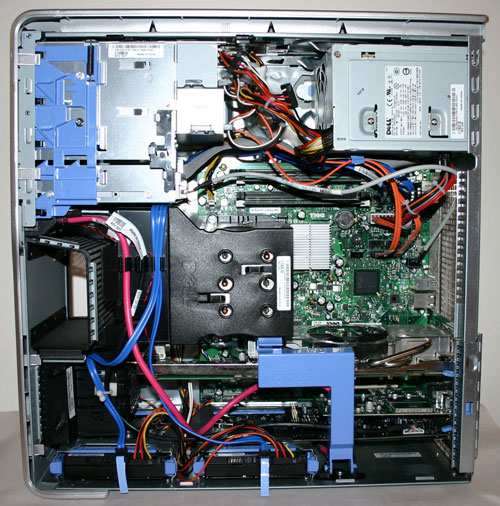 |
| Click to enlarge |
We were given a high-end configuration, complete with almost every accessory that most people would want. This has an interesting impact on the interior appearance, as you basically have a wide open middle section while the top and bottom of the case are more packed with components. The wiring isn't absolutely pristine like you might see in some of the higher end system integrator offerings, but most of the wires are secured at various points to keep them out of the way. Without a case window, we aren't too concerned about a few unsightly wires, and there's still plenty of open space allowing for ample air flow to keep your system interior cool.
 |
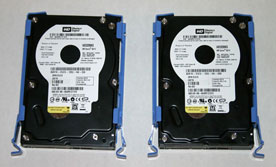 |
| Click to enlarge | |
At the bottom of the case are the two internal 3.5" drive bays, which are both occupied by 320GB 16MB cache Western Digital drives in our system. Both drives reside in plastic sleds that can be easily removed, but the drives themselves are secured to the sleds with standard screws. Dell set up our drives in a RAID 1 configuration, which will help protect users from data loss and downtime due to a failed hard drive. RAID 1 is not generally considered a backup solution, as it doesn't protect you from accidentally deleted files, viruses, or data corruption issues that might occur, but as a means of improving uptime it is definitely useful. If you need more storage capacity, you can opt for larger drives and/or omit the RAID 1 configuration (or perhaps go with RAID 0 for enhanced performance at the cost of reliability). If you want to add more than two hard drives, you could use the 3.5" or 5.25" external bays (with an adapter for the 5.25" bays).
The 375W power supply had no problems running our test configuration, which is basically loaded up with most of the high-end features you might want to add. A third or fourth hard drive would use a bit more power, as would larger drives, but even if you filled every available expansion slot it would be difficult to overload the power supply with current components. The story might change in the future with the release of the next-generation video cards from NVIDIA and ATI, unfortunately, so in the long term the PSU may prove insufficient. Most people don't generally buy Dell computers for their extensive upgrade capability, so this probably isn't a major concern for them. On the other hand, those who might want a G80 or R600 could very likely find themselves in need of a higher performance PSU.
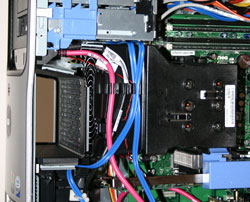 |
| Click to enlarge |
That brings up another point that's important to mention. In the past, Dell has been somewhat notorious for including proprietary power connectors and motherboard designs. Starting about a year ago, all motherboards should now be using a standard 24-pin ATX power connector with an additional 4-pin ATX 12V connector. It was possible to get adapters in the past that would allow the use of a generic power supply, but this is now unnecessary. If you decide that you want something better than the standard 375W power supply in the future, it should not be at all difficult to replace the power supply. It would still be better to get a higher capacity power supply in the first place, especially given the price of the system, but as stated the 375W power supply should be sufficient for the vast majority of users.
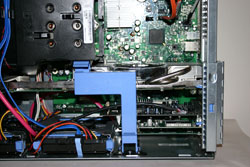 |
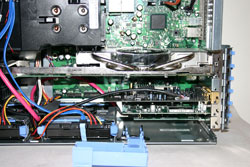 |
| Click to enlarge | |
We spoke earlier about the expansion card slots and the tool-less mechanism that is used to secure them. You can see a close-up shot of this area in the above pictures. First, you have the main blue latch that helps hold all of the expansion cards in place, and it also provides for some cable routing. This latch snaps into the bottom of the CPU heatsink duct. At the back of the case, you have a hinged clamp that holds all of the expansion brackets in place, and there are slight protrusions that slip into the screw notches in order to fully secure the cards. Opening the hinge is accomplished by pressing the two small "buttons" and then the whole door swings open. The whole system is extremely slick, and we would really like to see something similar make its way into standard ATX cases. It's almost a shame that most people that purchase an XPS 410 are unlikely to appreciate the ease with which the system can be upgraded.
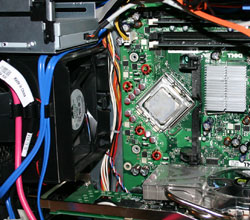 |
 |
| Click to enlarge | |
It is extremely easy to access all the components within the XPS 410. The most difficult component to replace is the CPU, and event that task is relatively simple. Two screws are used to secure the plastic duct that also holds the heatsink in place. Loosen those two screws, gently pull back on the CPU duct, and it should come loose giving access to the CPU socket. While the Dell heatsink isn't the largest we have seen, considering that there are no overclocking options on the system and that Dell doesn't ship the XPS 410 with the X6800 processor and the cooling solution should be more than sufficient. Future upgrades to quad core CPUs should also work, provided Dell releases an appropriate BIOS update.
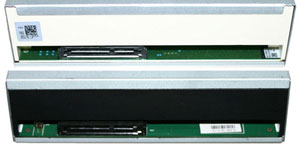 |
 |
| Click to enlarge | |
One item of interest is the optical drives that Dell includes. The system is entirely legacy free, which means there are no PS/2 ports, no serial ports, no parallel port, and with the use of the ICH8 Southbridge, there are no IDE ports either. There are six SATA ports, four of which are occupied in our configuration. Two of these are used for hard drives, while the other two are used for the optical drives. Dell includes a Toshiba TS-H553 16X DVD-RW for burning/backup duties, while a Philips DVD-ROM (a rebranded BenQ) serves as a second optical drive. Extensive testing of the DVD burner capabilities is beyond the scope of a system review, but we were able to burn and read a couple DVDs without issue. Both optical drives are average in terms of noise levels, which means at maximum speed they are actually louder than anything else inside the system. Luckily, optical drives don't need to run continuously. Unfortunately, SATA optical drives currently cost more than IDE optical drives, which likely adds an extra $50 or so to the system price.
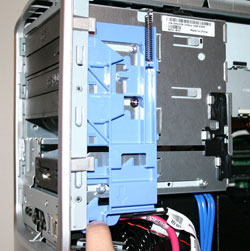 |
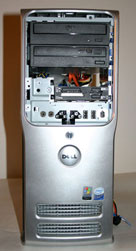 |
| Click to enlarge | |
Accessing the drive bays is once again an exercise in convenience. All you have to do is press down on the blue locking mechanism, and that will release the front cover and allow you to slide out any of the drives. The drives use screws as a sort of mounting rail, so if you want to replace a drive you will have to break out a screwdriver, but if you just need to temporarily remove the drives the process is very simple.










50 Comments
View All Comments
mino - Monday, September 18, 2006 - link
Otherwise this machine is pretty solid, no question about it, ideal for making your average clueless kid an game addict.One thing not reasonable is the lack of RS232, LPT, PS/2 and FW, that makes it unusable as far as I'm concerned.
Just wonder, will the ATX channel case builders ever actually LEARN how to make a proper AND cheapo case???
It is possible and pretty easy to do at the same time, yet they are like afraid to make a killer product...
Bluestealth - Tuesday, September 19, 2006 - link
Really...
Most mouses nowadays are usb
Keyboards also come in usb(although there are still a lot of PS/2 keyboards),
RS232... USB Serial Port?(I realize the network guys use these, but they are obsolete for the general person),
FW... I haven't run into something that "required" this for a while,
LPT... soon there won't be many LPT printers left surviving, and again there are USB adapters.
I wish my new motherboard didn't have RS232/LPT/PS/2, they just waste space.
It did however come with lots of USB and 2 FW ports, which is nice.
mino - Tuesday, September 19, 2006 - link
PS/2 usually just works, USB works, OS loads up and USB mouse turns off.I had amny times such a situation.That was just a single example..
I am OK with an no-legacy approach as along as it is meaningfull.
However to make legacy-free boards by removing all legacy stuff and not use the place for any other usage (i.e another 4-6 USB ports) is stupid.
Also 6 USB ports as a complete I/O ? that's a joke!
keyboard, mouse, printer, scanner, monitor, RS232 adapter and you have not a single port left!
6 USB is nice if you have all that legacy - the big reason we use PS/2 KB and mouses is it frees up 2 USB ports.
As for RS232, there is s huge amount of various equipment _produced_ for RS232! Why? because it makes no sense to go (pretty complicated vs. RS232) USB for simple data-reporting tasks.
Bluestealth - Tuesday, September 19, 2006 - link
Some companies use a USB to serial chip (or emulation) to allow them to easily upgrade their products, and for something that was designed with USB in mind, which is ever increasing, it will cease to be a problem.I currently have 1 USB Joystick, 1 Keyboard/Mouse Transceiver, 1 RF Remote. That is only 3 ports for me, I have 4 Rear USB ports, can add 4 more, a 4 port hub (plug stuff in on my desk easier), and have 2 front USB ports. For a majority of people 6 is NO PROBLEM, there are USB hubs for a reason though.
These computers are not designed for everyone, they are designed for most people, most people nowadays will not use the LPT/serial ports, while a lot still may still use PS/2 ports dell "provided" a USB keyboard and mouse. Most people have a mouse, keyboard, printer, and "maybe" something else such as a scanner.
It would be great if there were 8 USB ports on the back but I am assuming the last 2 went to that card reader. Intel decided on 10 USB ports, dell would have to add in card to support more, or add an additional chip to the board.
Monitor... did you not see the 2 DVI ports? (I don't know how you even justify listing this), RS232 is not required for most people.
Ok I did go on a rant, but this just screams of stupidly, USB is an expandable bus; it doesn’t have a fixed number of ports, only devices which is 127(?) per controller.
Sure they are saving quite a bit of money on an I/O chip from winbond, but in the end it doesn’t affect many people, so why not?
JarredWalton - Tuesday, September 19, 2006 - link
Two USB on the front, six on back, two more to the flash reader I think. Keyboard+mouse takes one port (the keyboard has two extra ports on it). You've got printer, scanner, headphones, network, and maybe one or two other things that can go USB, but that still leaves one extra port for most people. An LPT/Serial card is an option if you want that (it will use a PCI slot). Most people don't need it, though. If they had put firewire in the extra rear space, that would have allowed the use of a PCI LPT/COM and still have the sound card and TV Tuner. Not sure about PhysX, though... need a PCI-E version I guess.mino - Monday, September 18, 2006 - link
"even on customs" => "even in the case of a custom setup"kmmatney - Monday, September 18, 2006 - link
Dells Suck!Just kidding. When my Mom needed a new computer I had her buy a Dell. Its been trouble-free for several years.
Jetster - Monday, September 18, 2006 - link
i'm really impressed with the case design,especially the internal layout, excellent airflow. easily better than the most standared atx case you can buy on the market now. and AT's statement is so true: "It's almost a shame that most people that purchase an XPS 410 are unlikely to appreciate the ease with which the system can be upgraded."BTW did Dell use the new video card design with the chipset on the other side? casue the hsf is facing upward, which is better imo
Homerboy - Monday, September 18, 2006 - link
yeap. They are designed well, implemented even better and can't be beat bang for the buck. Sure higher-end and performance PCs will never be an pre-builts bread and butter, but they do it perfectly fine for the masses who don't know how to do it themsleves.And as far as their run-of-the-mill "workstations" and home PC are concerned. You simply can_not_beat a big-name manufacture on price and support.
(*please note I build all my own PCs, but family, friends, and workplace all get pre-builts... Dell's actually).
JarredWalton - Monday, September 18, 2006 - link
BTX motherboards have the slots flipped, so the case opens on the right instead of the left. That makes the GPU HSF face upward, as you can see. I didn't go into extreme detail on the BTX format, as I figure the images illustrate it well enough. :)